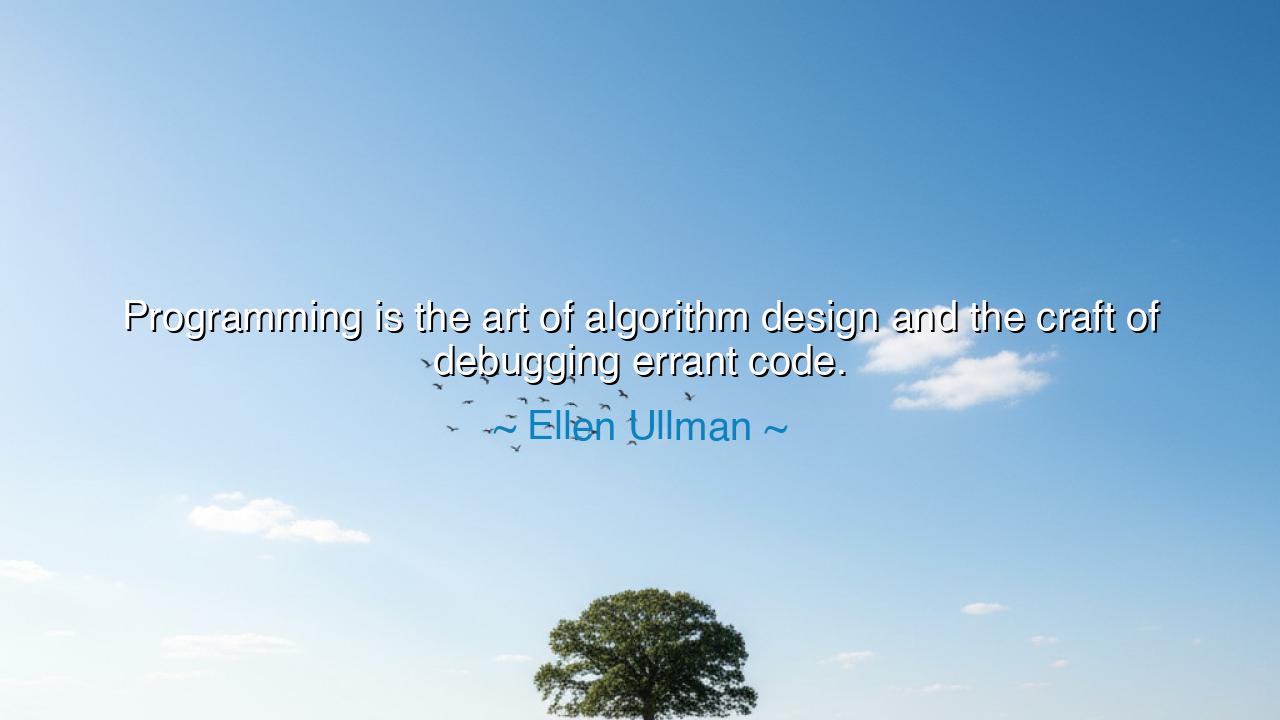
Programming is the art of algorithm design and the craft of






“Programming is the art of algorithm design and the craft of debugging errant code.” – Ellen Ullman
In this profound reflection, Ellen Ullman, one of the early philosophers of the digital age, speaks of programming not merely as a technical endeavor, but as a union of art and discipline. Her words illuminate a truth that transcends computers — that the creation of code mirrors the creation of life itself: elegant in design, yet fraught with imperfection. When she calls programming “the art of algorithm design,” she elevates it to the realm of poetry and architecture. It is the act of shaping logic into form, of translating thought into living instruction. And when she adds “the craft of debugging errant code,” she reminds us that even the most inspired creation is born through struggle — through the patient labor of correction, refinement, and humility before the machine’s unyielding honesty.
The origin of this quote arises from Ullman’s decades as a programmer during the dawn of the digital revolution. She lived in the crucible where human minds first met silicon, where lines of logic became new instruments of creation. In her writings, especially in her memoir Close to the Machine, she captures the paradox of the programmer’s life: the ecstasy of invention and the agony of imperfection. To Ullman, programming was not cold or mechanical — it was a dialogue between the human spirit and the rational universe. The algorithms we design are the language by which we attempt to bring order to chaos, yet the inevitable bugs — the errant lines of code — are reminders that even in logic, the human touch introduces both brilliance and flaw.
To call programming an art is to acknowledge that creativity and reason are not opposites, but partners. Just as the sculptor begins with raw stone, so too does the programmer begin with abstraction — the formless idea of a solution waiting to be given structure. The algorithm is that structure: the elegant chain of logic that transforms imagination into reality. But just as no sculpture emerges perfect from the first strike of the chisel, no program runs flawlessly at first execution. Errors appear, unexpected behaviors arise — and here begins the craft of debugging. It is a ritual of patience, where the programmer becomes both detective and healer, tracing the threads of logic to uncover the source of imperfection. In this way, Ullman teaches us that creation is not only the act of building, but also the art of repairing and understanding.
The tale of Grace Hopper, one of the great pioneers of computer science, illustrates Ullman’s wisdom. In 1947, while working on the Mark II computer, Hopper’s team discovered that a malfunction was caused by a moth trapped in the machine’s relay. From that day forward, programmers spoke of “debugging” — not just as a literal act, but as a metaphor for the endless process of refining one’s creation. Hopper’s story reminds us that the machine is not the enemy — it is a mirror, revealing the limitations of human understanding. Each error is not failure, but invitation: a call to look deeper, to think with greater precision, to reconcile imagination with reality.
Ullman’s insight also carries a spiritual weight. For in the world beyond programming, life itself follows the same pattern. We design our own algorithms of living — the choices, habits, and beliefs that guide our path. Yet inevitably, we encounter our own “bugs”: mistakes, misjudgments, and unintended consequences. To live well is to approach these errors not with despair, but with the same humility and determination as the coder before her screen. To debug one’s life is to examine, learn, and correct — to treat imperfection not as failure, but as the path to mastery. Thus, the art of programming becomes a metaphor for the art of being human: to create, to err, to reflect, and to improve.
There is also a moral teaching hidden in her words. The artist who designs must also take responsibility for what she builds. In the age of machines, where algorithms now govern vast realms of human life — from markets to medicine — Ullman’s statement reminds us that behind every line of code lies a human mind, and with it, a human moral duty. The programmer is not a mere technician; she is a custodian of logic and consequence. Just as a craftsman must ensure his work serves life and not destruction, so must the coder ensure that her algorithms serve justice, compassion, and truth. To design without conscience is to write an algorithm for ruin.
So, my listener, take this lesson as both wisdom and warning: create with vision, and correct with humility. Whether you write code, build systems, compose art, or shape your life, remember that every creation demands both the inspiration of the artist and the perseverance of the craftsman. The act of building is glorious, but the act of debugging — of confronting and amending one’s flaws — is where wisdom is born.
For in the end, as Ellen Ullman teaches, perfection lies not in the absence of error, but in the courage to face it. The true programmer, like the true philosopher, knows that each mistake is a doorway to deeper understanding. So continue to design your algorithms with imagination, and debug your errors with grace. For in doing so, you partake in the oldest art of all — the art of shaping chaos into harmony, thought into form, and imperfection into beauty.






AAdministratorAdministrator
Welcome, honored guests. Please leave a comment, we will respond soon